|
Home
Up
| |
~ Inca
Trails ~
March 1 through March 17, 2000
$1 U.S. = 3.40 sols
(Remember
to click on the thumbnails for enlargements of the photos)
Cusco, Cusco, Peru
March 1 through March 11
(ccl) We arrived in Cusco after
a (thankfully) brief layover in Lima. We landed at around 11:00 P.M.,
headed for a hotel where we had made a reservation a few days before in Mexico
City, and crashed as quickly as possible. I should mention here that we
flew a Panamanian airline, from Mexico City to Peru, and it was a
great experience. Brand new 737's, very nice service. I highly
recommend them. I think they fly out of Newark in the U.S. Another
detail worth mentioning is that the Panama City airport has the cheapest liquor
prices I have ever seen. We paid U.S. $5 for a liter of Stoli
Orange. So, if you're ever in the Panama City airport, check out the
shopping. Now, back to our story...
We got up pretty early the next morning
in order to get to the airport and get a flight to Cusco. We had
been told that this was easy to do at the airport, no need to make a reservation
ahead of time. Our trip through Lima back to the airport confirmed
our suspicions of the night before. Lima is a really grimy, smelly
city, with bizarre traffic that demands only the most seasoned of cab
and bus drivers. Once at the airport, we got in line at the Aero
Continente counter, because they had a flight to Cusco about an hour later.
After a couple of minutes of standing in line, we were told that the computers
were down, and that they could not sell us a ticket. We were kind
of standing around, trying to figure out what to do, when I looked over
and saw Wiley talking to a guy. Wiley then waived me down and said,
"Follow this guy.". We began walking through the airport.
Apparently, this guy had asked Wiley if he needed any help, and Wiley
said, yes, we need tickets to Cusco, and this guy said, "Follow me".
We were then introduced to two women, who took our passports, filled out
some tickets, and told us to take them to the ticket counter and check
in. We somehow managed to communicate this, plus the fact that we
would pay them U.S. $79 per ticket once we had the boarding passes.
I could not believe this was happening! Who were these people, and
how could they just sell tickets at the airport??? Well, we were
able to check in our luggage, get the boarding passes, and pay the women
for the tickets, all with no problem. I guess they were travel agents
hustling for a little extra business at the airport.
At this point we had only 15 or so
minutes before our flight was supposed to leave, so we ran through security and
to the gate our flight left from. We handed our boarding passes to the
gate attendant, who tore them and pointed to a plane on the tarmac. We
boarded the plane and settled into our seats. About 5 minutes later, the
guy who had taken our boarding passes came onto the plane to get us, letting us
know that we were on the wrong flight, and that our plane wasn't boarding
yet. Hello, my name is Chaos, and I'll be your guide through the third
world...
 The flight to Cusco takes only an hour from Lima, but it is a world away.
When you get off the plane, you notice the fresh mountain air, which is a huge
improvement over the polluted smog of Lima. Cusco is apparently
often called the "Kathmandu of South America", and while I haven't yet
been to Kathmandu, I can imagine why the comparison is made. On the one
hand, Cusco has a party atmosphere 24 hours a day, with numerous discos,
restaurants, and bars, all working hard to earn your business. It's also
the logical beginning for trekking the Inca Trail to Machu Picchu, so there are
hundreds of travel companies and camping equipment rental places. But
Cusco has so much more to offer. The Incas called Cusco the "Navel
of the World", and it was the center of their vast empire. At many
places around the city, parts of Inca walls are still visible, huge blocks of
granite, cut with exacting precision and fit together perfectly with no
mortar.
The flight to Cusco takes only an hour from Lima, but it is a world away.
When you get off the plane, you notice the fresh mountain air, which is a huge
improvement over the polluted smog of Lima. Cusco is apparently
often called the "Kathmandu of South America", and while I haven't yet
been to Kathmandu, I can imagine why the comparison is made. On the one
hand, Cusco has a party atmosphere 24 hours a day, with numerous discos,
restaurants, and bars, all working hard to earn your business. It's also
the logical beginning for trekking the Inca Trail to Machu Picchu, so there are
hundreds of travel companies and camping equipment rental places. But
Cusco has so much more to offer. The Incas called Cusco the "Navel
of the World", and it was the center of their vast empire. At many
places around the city, parts of Inca walls are still visible, huge blocks of
granite, cut with exacting precision and fit together perfectly with no
mortar. 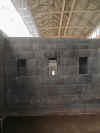
Our first order of business once we
got our luggage and got in a taxi was to head to the office our our Spanish
school, ACUPARI, to check in with them and meet up with the family we would be
staying with during the next 10 days while we learned Spanish in Cusco.
Once at ACUPARI, we met the director of the school, whom we had been emailing
for several months, Amparo Garcia. Amparo turned out to be one of our
Spanish teachers as well, and she introduced us to Senor Miguel Landa, in whose
home we would be staying. Miguel took us via taxi to his comfortable home
10 minutes from the center of the city. We had a big lunch (a Peruvian
tradition, we found out), met the family, which consisted of Miguel's daughters,
Claudia and Patricia, and Patricia's husband, Amadeo, and then crashed for
several hours in the room.
I can't say enough great things about
our experience at ACUPARI. The school is run in conjunction with the
German Consulate office in Cusco, so there are many German travelers there
learning Spanish. The first day of class for us turned out to be a field
trip to the nearby ruins of Tipon and Pikillaqta. Tipon was particularly
interesting to us because the Incas used it not only as a area to purify and
bless the waters coming down from the mountain, but also as a place to grow
medicinal plants among the many terraces built from stone. The Incas
actually understood micro climates, and were able to grow important plants that
are not indigenous to the mountain area on these terraces by bringing soil from
coastal or jungle areas.
On Friday morning we settled down for
our first Spanish lesson. School started at 9:00 A.M., but prior to that
everyone stands outside their classroom and sips coca tea and chats.
Everyone speaks English, but we ARE in Spanish class, so we tried to speak
Spanish with others. It's so easy for the Germans to switch from Spanish
to German to English! It should embarrass all Americans that we speak only
English. We made many great friends at ACUPARI, and hope to meet up with
them again one day on our travels. 
We quickly settled into life in Cusco.
I guess this is a luxury you don't get during a two-week vacation. Every
morning, we got up at 7:00, had breakfast with Miguel, discussed (as best we
could) Peruvian politics, then headed to ACUPARI for class. From 9:00 to
10:30, Sandra was our teacher, then we had a 30 minute break for coca tea and
cookies, and then Amparo was our teacher for the next hour and a half. On
our first day of class, we were given a test to determine how well we understood
Spanish. I don't think I did very well, but let me say here that I never
took Spanish in school. That's my disclaimer, and I'm sticking to
it. Wiley knows what he's doing, due to two years of high school Spanish,
but even he said that he learned more the first day than he did in all of high
school. The format is that the teachers speak Spanish almost entirely, and
only speak English when necessary to explain a word or a concept. We did
exercises in a book, and also conversed a good bit. Conversation was hard
for me, because I felt like I didn't have enough of a command of the language to
even construct a sentence. But things got easier as the days went on, and
we both learned alot. Most people were there for 4 weeks of school, and
they truly learned Spanish. I would highly recommend this program
to anyone who wants or needs to learn Spanish in a relatively short period of
time. They also teach German at the school.
After class every day, we returned to
Miguel's house for a huge Peruvian lunch. Claudia joined us for this meal,
along with Patricia and Amadeo. Claudia is a student at the University in
Cusco, and she was on break while we were there. She wants to go to Sao
Paulo after graduation to work, because there are many jobs in finance
there. Amadeo and Patricia both work at a bank in Cusco. We were
told that the banking jobs are the best ones in Peru. Miguel is a retired
engineer, who now hosts Spanish students in his home. He is a wonderful
person, and we enjoyed his commentary on the political environment in
Peru. He reminded me alot of my own father, and even got up at 5:45 A.M.
on the day we left to say goodbye to us once more. Staying with Miguel and
his family completely enhanced our visit to Cusco, and we will never forget
their wonderful hospitality. 
After lunch every day, we either
fought off or succumbed to the urge to take a nap, then ventured into town for
sightseeing or errands. Our troubles with American Express continued into
our time in Cusco, but by the beginning of our second week there, our travel
funds had been transferred into our checking account, and we were able to pay
bills. This is probably a good time to talk about the prominence of the
Internet cafe in tourist areas. We've had no trouble finding them, but the
price and speed of service varies dramatically. In Cusco, you can get an
hour at most places for 2.50 sols. In Mexico City, we were paying about 10
pesos for an hour, but the speed was incredible - even faster than a T1 line. The best advice I can
give if you're taking a long trip is to make sure that your email provider
allows you to access your email over the web. All of the free providers,
like Hot Mail and Yahoo! allow this, but we wanted to be able to download our
email onto our computer AND get it on the web. That's why we went with
Speedfactory.
Cusco is full of interesting ruins,
museums, and old colonial houses, and you can easily fill two weeks time
exploring the sites and soaking in the culture. Almost everything is
cheap, from the U.S. $10 tourist ticket for all the major sites, to 17 sols for
6 kilograms of clean, folded laundry. One of the highlights of the city is
the Inca Museum, which is very well done, although none of the information is in
English (yet another reason to learn Spanish). We enjoyed seeing mummies
from ancient Inca burial sites, and skulls showing early Inca attempts at
neurosurgery  Also amazing are the Inca temples at Koricancha. Koricancha was an
incredible Inca place of worship when the Spanish arrived in Cusco in 1533, with
temples to the sun, the moon, and the stars. Francisco Pizarro ordered the
temple destroyed and a Dominican monastery built in its place. Many of the
original Inca walls were left standing, and while subsequent earthquakes
destroyed the colonial buildings, the Inca walls were left standing,
intact! The Incas understood that building their walls on a slight angle,
and anchoring them in a soft material, like sand with pebbles, would allow the
walls flexibility during seismic activity. One of the many amazing sites
the Spanish saw when they arrived in Cusco was the Artificial Garden at
Koricancha. Written accounts tell us that this garden contained flowers and
plants created by the Incas out of gold, silver, turquoise, and other precious
stones. It must have been quite a site! Of course, the Spanish
wasted no time plundering the place, as they had all over Central and South
American, in the name of the Catholic church. So, unfortunately, at this
point, we can only imagine...
Also amazing are the Inca temples at Koricancha. Koricancha was an
incredible Inca place of worship when the Spanish arrived in Cusco in 1533, with
temples to the sun, the moon, and the stars. Francisco Pizarro ordered the
temple destroyed and a Dominican monastery built in its place. Many of the
original Inca walls were left standing, and while subsequent earthquakes
destroyed the colonial buildings, the Inca walls were left standing,
intact! The Incas understood that building their walls on a slight angle,
and anchoring them in a soft material, like sand with pebbles, would allow the
walls flexibility during seismic activity. One of the many amazing sites
the Spanish saw when they arrived in Cusco was the Artificial Garden at
Koricancha. Written accounts tell us that this garden contained flowers and
plants created by the Incas out of gold, silver, turquoise, and other precious
stones. It must have been quite a site! Of course, the Spanish
wasted no time plundering the place, as they had all over Central and South
American, in the name of the Catholic church. So, unfortunately, at this
point, we can only imagine... 
Our other favorite site in Cusco was
Sacsayhuaman, the huge fortress/temple that looms over the city on a hill
above. We arrived there on a rainy afternoon, and things were slightly
soggy. We were approached, as usual, by one of the many
"unofficial" tour guides in Cusco, and I must admit that I was
hesitant to hire him. There is currently a big demonstration underway in
Cusco by the "official" tour guides regarding the
"unofficial" tour guides. In Peru, you can go to University for
5 years to get a degree in tourism, and this qualifies you to be a tour
guide. OR you can learn another language, like English or German, read up
on all of the pertinent information about the local sites, then pass a test, and
PRESTO! you're a tour guide. Needless to say, the people who have
gone to school for 5 years aren't happy about this, and there was a hunger
strike underway on the square when we were in Cusco to protest this. I
must say that we had both types of guides while in Cusco, and they were all
excellent, including Pacho, our guide at Sacsayhuaman.
The archeologists disagree on exactly
what Sacsayhuaman was, but popular thinking places it as yet another Inca
temple. As I said, it's on a hill overlooking Cusco, and it is quite
impressive. Some of the stones used to construct the walls weigh upwards
of 300 tons! There are many theories about how the Incas moved the stones
to Sacsayhuaman to build the walls, but most people believe they used a system
of tree trunks and ropes. Once the stones were at the site, a hole was
dug, and levers where used to upright the stone. After seeing Sacsayhuaman,
all I could think was, "What is the big deal with
Stonehenge???". 
After a hard day of sight-seeing, one
must take a little time off to reflect on the day, and in Cusco, there are
numerous places to do just this. I called Cusco a cross between
Breckenridge and New Orleans to a friend in a email earlier, and I think this is
pretty accurate. Everyone wants to give you a flyer about their bar or
restaurant, advertising their special dinner or happy hour. I'm thinking
of selling t-shirts to the tourists that say, "No Tango Hambre", which
means, "I'm not hungry", in English. That way, people won't
bother you to look at their menus. But, hey, they're just trying to make a
living.
One of our main nighttime activities
while in Cusco was meeting with our TANDEM partners. TANDEM is part of the
ACUPARI program. It's completely voluntary, but encouraged, and ACUPARI is
one of only three Spanish schools in Latin America that offers it. It
works this way: you are paired with a local person who is trying to learn your
native language, and every day you meet for an hour or so. During your
meeting you speak Spanish half of the time and English (in our case) the other
half. You discuss current events, your life back at home, your activities
while in Peru, etc. My partner was a recent tourism graduate from the
local University named Nury Sosa. Nury spoke great English and certainly didn't
need my help, but she really helped me. Wiley's partner was a local
teacher who hopes to moved to the United States one day soon. We both
really enjoyed getting to know these two great people and felt that it really
enhanced our understanding of Peruvian culture and people. 
One of the most amazing things about
travel is that you meet all kinds of people. I've already talked about the
great folks at ACUPARI, both the students and the teachers. We also met
many Peruvians whom we formed lasting friendships with. One night, while
having a beer in a bar, we struck up a conversation with a guy at the bar who
spoke great English. His name was Arturo, and he invited us to his house
the next night for dinner. We went salsa dancing with him and two other
new friends, Catherine and Florian from Germany. Arturo seems to know
everyone in Cusco, and, as Florian said, you never pay a cover when you're with
Arturo. Even Arturo's dog, Chaski, was welcome at the clubs! 
If you're ever in Cusco, stop in at
Rosy O'Grady's on Santa Catalina Ancha. It's owned by an Irish guy named
Charlie who came to Cusco on vacation, loved it, and opened a bar. We
spent a couple of very fun happy hours there, and got to know Freddy the
bartender pretty well.  We plan to spend tomorrow, St. Patrick's Day, there.
We plan to spend tomorrow, St. Patrick's Day, there.
On our last day at ACUPARI, Friday,
March 10, Sandra took us to visit a local hospital where they have a clinic to
dispense medicinal herbs to people who can't always afford traditional
medicines. This is just another example of how amazing ACUPARI is - Wiley
mentioned that he was interested in healing with plants and natural medicine
once, and they set up this visit for us. When we got there, the director
was out, so her 10 year old son, Joel, showed us around the herb garden, and
told us how each of the plants was used to heal certain ailments. TEN
YEARS OLD!! He gave us each a gift of some herbs, one in particular that
is used to calm nerves. Perhaps he sensed the stress I had felt earlier
over this computer... 
On Friday night, we packed our bag
for the Inca Trail. We were scheduled to leave at 6:00 A.M. Saturday
morning with our tour group from the SAS company. Deciding on which tour
to go with on the Inca Trail is similar to picking a college. Well, maybe
I'm exaggerating, but it's not easy. There's alot of companies in the U.S.
$55 range, then the price jumps to about U.S. $90, and from there it spikes
wildly to upward of U.S. $300. One afternoon, Wiley visited about 10
places, and identified SAS as his favorite (Arturo had also recommended
it). SAS charged about U.S. $88 per person for the whole trip, but they
promised a tent to eat in and Wiley just got a good feel about the place.
But after reading some information we had from the South American Explorer's
Club, we became concerned that we might have gone too quickly with a low-quality
organization. One source told us that if you pay much less than U.S. $120,
you're going with a shoddy organization. So in order to do proper due
diligence, we visited with a place recommended by the South American Explorer's
Club. These guys charge U.S. $269. and the only thing we could figure that
was different about them was that they bought your bus ticket down the mountain
from Machu Picchu, which costs 16 sols. So we stuck with SAS, paid our
money, and got ready for the trip.
The Inca Trail,
Parts Unknown, Peru
March 11 through March 15
Day One: "This is easy!"
(ccl) 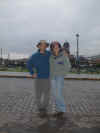 We arrived at the SAS
office at 6:00 A.M., as directed. When we went downstairs to get in the
cab to leave the house at 5:45, we found Miguel waiting to wish us one last
goodbye.
We arrived at the SAS
office at 6:00 A.M., as directed. When we went downstairs to get in the
cab to leave the house at 5:45, we found Miguel waiting to wish us one last
goodbye.
Several of our fellow travelers had
already arrived, and gradually everyone met each other as we piled into the
doorway of the travel agency (despite the fact that we had been warned not to be
later than 6:00, no one was at SAS to open the place up until 6:20 or so).
There was Spacanica and Bettina, recently graduated doctors from Switzerland,
who were traveling around South America for several months before returning home
to face "The Real World", Bea, Georgia, and Martin, who had all gone
to boarding school together in England, and who were also doing some traveling
before going to university, and Peter, a mechanic from Switzerland. After
breakfast, we hopped on the bus and took off. Our guide, Mauricio, popped
up once to introduce himself, then crashed for the rest of the ride.
We made two stops on the way to the
trailhead. One was in the town of Urumbamba to pick up a couple of extra
porters for the trek. When our bus stopped. about 30 men surged towards
the door, some o them extremely desperate-looking. Mauricio picked two or
three, then we were on our way again. He later told us that he hates this
part of the trip; that some of the men need the $20 for 4 days of extremely hard
work so badly, and he feels bad that he can only take a few. We stopped
once more for a 30 minute break in the small ancient town of Ollantaytambo.
As Wiley and I wandered through the narrow, cobbled streets, we came upon an old
man with a bundle of dried corn stalks, who beckoned us to follow him. I
was not for this, as we had only been given a thirty-minute break before we were
to be back on the bus, and what kind of people follow strange old men around
strange towns, anyways? Us, apparently, because before I knew it, we were
at the door to his house. He opened the door, threw the dried stalks on the
floor, and made some little chirping noises. All of a sudden, 25 or so
guinea pigs came skittering from every corner of the place to munch on the
stalks. Guinea pig, or "cuy", is a culinary delight in Peru, and
it was a little sad knowing these cute little guys would be someone's dinner
soon. The old man then beckoned us to follow him upstairs to see something
else, but I exerted my full influence at this moment and insisted that we needed
to get back to the bus, so we gave the guy a little money and said goodbye to
him and his guinea pigs. 
The road past Ollantaytambo was
awful, and seemed nearly impassible at spots. After much maneuvering, we
reached the trailhead, called "Kilometer 82" because of its position
on the railroad line between Cusco and Aguas Calientes, the town at the foot of
Machu Picchu. There are actually two Inca Trails, a religious pilgrim's
trail and another communication trail. We were taking the pilgrimage
trail. 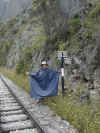
We had paid $40 extra to have our
backpack ported. Maybe we didn't fully "experience" the Camino
Inca (literally, in Spanish, "Inca Walk") because of this, but we
decided it was better to enjoy the scenery than to struggle and be miserable.
After about two hours of walking on
easy, rolling terrain, we stopped for lunch in a nice meadow overlooking a
valley. There were three other groups starting the trail that day, and we
noticed that the two groups from SAS were the only ones having lunch in a tent
with a table and chairs. We didn't yet realize the importance of this...
 We walked for a couple more hours
that day. The scenery was beautiful, and wildflowers were blooming all
along the trail. At about 4:30 we arrived at our camp for the night, where
the porters had already arrived, and had set up our tents. There was also
tea and animal crackers waiting for us, and dinner soon followed. We walked for a couple more hours
that day. The scenery was beautiful, and wildflowers were blooming all
along the trail. At about 4:30 we arrived at our camp for the night, where
the porters had already arrived, and had set up our tents. There was also
tea and animal crackers waiting for us, and dinner soon followed.
We talked alot during tea and dinner
and got to know our fellow travelers and our guide better. Bettina and
Spacania had just spent five weeks in Ecuador together, learning Spanish and
staying with a family there. We really enjoyed talking with them about the
state of medicine in both the U.S. and Switzerland. The British kids were
really enjoyable to be around. They were extremely well-traveled, and very
interesting to talk to. I don't know if I could have spent four days with
most American 18-year olds. Peter was quiet but very funny. He wants
to get into another career, and loves physics, of all things. Mauricio,
our guide, was great. He always had a smile on his face, and every night
he prepared us for what the next day's hike would be like. He told us
about how he had grown up in a one-room house with his parents, six brothers,
and one sister. Learning English on his own had enabled him to get a good
job in tourism.
We went to bed knowing that the next
day, my birthday, would be the most difficult. We had eight hours of
hiking and two mountain passes ahead of us, so we turned in
early.
Day Two:
"Yes, I feel thirty-six", or "Put the Stairmaster on 10 and stay
on it for for five hours"
We were awakened at 5:30 A.M. by a
noise just outside our front tent flap, and strange foreign voices. After
a couple of minutes we came to our senses and realized that it was two of our
porters waking us up for the day with hot coca tea. In the Andes, the
leaves of the coca bush are drunk as a tea to combat altitude sickness and aid
digestion. That's right - it's the same plant that's used to make cocaine,
the scourge of the American ghetto. Coca has been used for thousands of
years in the Andes , both as a tea and as a chew. Several leaves are
placed in the mouth with a piece of bicarbonate, which causes the leaves to
release the substance in them that gives a lift. The use of the leaves in
both of these forms is completely safe and non-addictive.
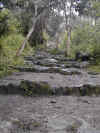 We hit the trail at 7:00 sharp, as we
had eight hard hours of hiking ahead of us. The hike began very
pleasantly, with a couple of hours of gentle uphill hiking through dense
jungle-like terrain. It was beautiful, and part of the hike went along a
rushing mountain river. About two hours down the trail we hit a rest stop
in a lovely mountain meadow, and then the real hiking began. For the next
hour and a half we plodded pretty much straight uphill. The air was getting
noticeably thinner, so our breath was becoming more and more labored. Our
goal was the highest point on the Inca Trail - Dead Woman's Pass, 4198
meters. Mauricio told us that the pass (Abra de Huarmihuanusca, in Quetcha,
the language of the Incas) was called that because it looks like a woman lying
down, not because some woman died trying to get to the top of it, a fact I was
glad to hear on my 36th birthday. We reached the top at around noon, but
didn't stay long to celebrate, because it was windy and cold up there. We hit the trail at 7:00 sharp, as we
had eight hard hours of hiking ahead of us. The hike began very
pleasantly, with a couple of hours of gentle uphill hiking through dense
jungle-like terrain. It was beautiful, and part of the hike went along a
rushing mountain river. About two hours down the trail we hit a rest stop
in a lovely mountain meadow, and then the real hiking began. For the next
hour and a half we plodded pretty much straight uphill. The air was getting
noticeably thinner, so our breath was becoming more and more labored. Our
goal was the highest point on the Inca Trail - Dead Woman's Pass, 4198
meters. Mauricio told us that the pass (Abra de Huarmihuanusca, in Quetcha,
the language of the Incas) was called that because it looks like a woman lying
down, not because some woman died trying to get to the top of it, a fact I was
glad to hear on my 36th birthday. We reached the top at around noon, but
didn't stay long to celebrate, because it was windy and cold up there. 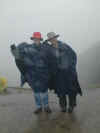
Now we had another hour and a half of
downhill hiking ahead of us to get to our lunch spot. Sounds easy, but it
was almost as bad as the uphill part. In fact, our group unanimously
agreed that we preferred uphill hiking to downhill hiking by the end of the
trip. By this time, it was raining in earnest. Our legs were already
exhausted from climbing the first pass and the rock steps were about eight
inches high and somewhat treacherous because of the water.
When we reached the lunch spot, it
was pouring. This is where it became evident why our company charged a
little more. Our lunch tent was already set up, complete with hot tea and
coffee. The other tour groups were huddled under whatever overhang they
could find or in the bathroom, eating their lunches standing up.
 After lunch we had one more pass to
reach, this one called Abra de Runku Raquay, at 3800 meters. On the way up
we passed the second set of ruins we had seen on the trail. Both of these
were basically the "Days Inns" of the Inca Trail; places for the Incas
on religious pilgrimage to Machu Picchu to stop and rest. As part of the
pilgrimage the Incas carried no food or creature comforts with them, and these
rest stops allowed them some comfort along the way.
After lunch we had one more pass to
reach, this one called Abra de Runku Raquay, at 3800 meters. On the way up
we passed the second set of ruins we had seen on the trail. Both of these
were basically the "Days Inns" of the Inca Trail; places for the Incas
on religious pilgrimage to Machu Picchu to stop and rest. As part of the
pilgrimage the Incas carried no food or creature comforts with them, and these
rest stops allowed them some comfort along the way.
This was probably the most difficult
part of the hike, as the rains had produced several little streams that now
gushed down the path. Anyone who had managed to keep their feet dry to
this point now gave up and joined those who already had squishy socks. 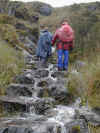
After the second pass we had another
hour of downhill hiking to reach our camp for the night, once again prepared
ahead of time for us by our porters. We rounded the last corner and were
treated to the sight of the ruins of Sayca Marca ("inaccessible city")
rising out of the mist. This was the first religious station of the
trail. The rain had ended, the sky was just beginning to clear, and the
sun was setting. We had survived Day Two!
That night we had another
delicious meal, followed by a traditional hot rum drink.
It was a cold and starry night, and we slept well from exhaustion.
Day Three:
"I feel the pain"
Day Three is the day that everyone
looks forward to when trekking the Inca Trail. It's relatively short (3
1/2 to 4 hours), downhill, and you begin feeling the anticipation that you are
getting close to the promised land: Machu Picchu. After about an hour and
a half of gentle uphill hiking, we crossed the third and final pass at the ruins
of Puyupatamarca (3600 meters), named the "City Above the Clouds" by
archaeologists, and the second religious station on the trail.  We stopped at Puyapatamarca long enough for Mauricio to explain about the three
worlds of the Incas: the lower world, where we are before birth, which
represented by the snake; this world, where we live now, represented by the
puma; and the upper world, what we would compare to heaven, represented by the
condor. The Peruvians still consider all of these animals to be
sacred. Both Sayamarca and Puyupatamarca were temples where Incas stopped
to worship on the way to Machu Picchu, archeologists believe. Much of what
we believe about the Incas is conjecture, since they had no written
language. This fact makes their accomplishments even more impressive, when
you consider the exacting and precise nature of their buildings and realize that
they wrote nothing down!
We stopped at Puyapatamarca long enough for Mauricio to explain about the three
worlds of the Incas: the lower world, where we are before birth, which
represented by the snake; this world, where we live now, represented by the
puma; and the upper world, what we would compare to heaven, represented by the
condor. The Peruvians still consider all of these animals to be
sacred. Both Sayamarca and Puyupatamarca were temples where Incas stopped
to worship on the way to Machu Picchu, archeologists believe. Much of what
we believe about the Incas is conjecture, since they had no written
language. This fact makes their accomplishments even more impressive, when
you consider the exacting and precise nature of their buildings and realize that
they wrote nothing down!
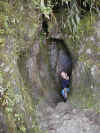 After the ruins, it was another hour
and a half of brutal downhill hiking to reach our lunch destination and campsite
for the evening, the trekker's hostel at Winay Wayna. I fell once on the
way down and bloodied my hand - those who know me know that with my clumsiness it
was inevitable at some point. No permanent damage.
After the ruins, it was another hour
and a half of brutal downhill hiking to reach our lunch destination and campsite
for the evening, the trekker's hostel at Winay Wayna. I fell once on the
way down and bloodied my hand - those who know me know that with my clumsiness it
was inevitable at some point. No permanent damage.
 After
lunch, we paid 5 soles each for a hot shower - quite a treat after three days on
the trail. Later that afternoon Mauricio took us over to the nearby ruins
of Winay Wayna, or "Forever Young", around sunset. This
extremely beautiful and tranquil place is the third and final religious station
on the trail, and it gives you a sense of what you are about to see at Machu
Picchu. There are rocky peaks all around and the snow-capped majesty of
Mt. Veronica is visible in the distance.
After
lunch, we paid 5 soles each for a hot shower - quite a treat after three days on
the trail. Later that afternoon Mauricio took us over to the nearby ruins
of Winay Wayna, or "Forever Young", around sunset. This
extremely beautiful and tranquil place is the third and final religious station
on the trail, and it gives you a sense of what you are about to see at Machu
Picchu. There are rocky peaks all around and the snow-capped majesty of
Mt. Veronica is visible in the distance. 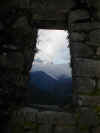
 After dinner we called our porters together (there were five porters and another
guy who did all the cooking) and presented them with a tip from all of us as a
show of gratitude. They were so humble and such nice people, and we
sometimes felt sorry for some of the guys who seemed to be carrying loads that
were way heavier than they should have been. These guys are, on average,
about 130 pounds, 5'5", and they are heaving loads in excess of 50 pounds
up and down these mountains. And they wear flip flops made of old tires -
no kidding. Mauricio told us about once when one of the tourists in his
group gave one of the porters his hiking boots, but the porter's feet were
bloody after wearing them only a few hours. One very important sign of a
good agency is how they treat their porters - and this is obviously not
something you can know when you sign up. From what we saw of the way SAS
did things, they treated their porters well. They had their own tent, they
ate the same food we did, and they had normal-sized loads.
After dinner we called our porters together (there were five porters and another
guy who did all the cooking) and presented them with a tip from all of us as a
show of gratitude. They were so humble and such nice people, and we
sometimes felt sorry for some of the guys who seemed to be carrying loads that
were way heavier than they should have been. These guys are, on average,
about 130 pounds, 5'5", and they are heaving loads in excess of 50 pounds
up and down these mountains. And they wear flip flops made of old tires -
no kidding. Mauricio told us about once when one of the tourists in his
group gave one of the porters his hiking boots, but the porter's feet were
bloody after wearing them only a few hours. One very important sign of a
good agency is how they treat their porters - and this is obviously not
something you can know when you sign up. From what we saw of the way SAS
did things, they treated their porters well. They had their own tent, they
ate the same food we did, and they had normal-sized loads. 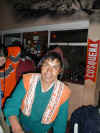
Once
again, we were wiped-out by 8:00, so we went to bed in anticipation of a 4:00
wake-up call for the final walk to Machu Picchu.
Day Four:
"I'm here, but now I just want to sleep"
This morning, no coca tea with the
wake-up call. We had to be out of our tents for breakfast at 4:30, because
we were hitting the trail at 5:00. Mauricio had said he was leaving at
5:00 with or without us, and apparently everyone believed him, because all eight
of us were early for breakfast. Mauricio had apparently been up late with
the other guides, but he led us out from Winay Wayna at 5 sharp. We
continued along the trail in darkness for 45 minutes or so. Around 6:00 we
reached the sun gate, high above Machu Picchu. This is where we had our
first sighting of Machu Picchu, and it was spectacular. We continued down
the trail for about 30 minutes until we reached the ruins. The object of
leaving camp so early is to see sunrise as it comes over the mountain and hits
Machu Picchu. Unfortunately, it was cloudy and we couldn't see the sun,
but at least it wasn't raining. 
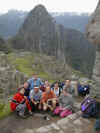 After 30 minutes or so of lingering
on the terraces on the hills above Machu Picchu, we posed for some group photos,
then headed down to the
admissions office to store backpacks and convene for our tour of the
ruins. At this point we were starting to mix with the tourists that were
getting off of the first buses coming up from Aguas Calientes, and it was a
little strange. I felt sort of like I had been on another planet for four
days. I'm not sure I was ready to mix with the outside world just
yet. We actually saw a Japanese couple standing in line with a guy behind
them holding an umbrella over them. Reality bites... After 30 minutes or so of lingering
on the terraces on the hills above Machu Picchu, we posed for some group photos,
then headed down to the
admissions office to store backpacks and convene for our tour of the
ruins. At this point we were starting to mix with the tourists that were
getting off of the first buses coming up from Aguas Calientes, and it was a
little strange. I felt sort of like I had been on another planet for four
days. I'm not sure I was ready to mix with the outside world just
yet. We actually saw a Japanese couple standing in line with a guy behind
them holding an umbrella over them. Reality bites...
 We were exhausted during the three hour tour of the ruins, and although
it was very interesting, we barely stayed awake for it. Before we
left Cusco, we had made reservations at the Machu Picchu Pueblo Hotel
in Aguas Calientes, and I was thinking non-stop about a hot shower and
some nice white sheets. Wiley's parents had stayed there during
their 1999 trip to Machu Picchu, and had highly recommended it.
So we made the hour-long hike down the mountain, picked up our bag from
the restaurant where the porters had brought it, said goodbye to our new
friends, and headed for the promised land.
We were exhausted during the three hour tour of the ruins, and although
it was very interesting, we barely stayed awake for it. Before we
left Cusco, we had made reservations at the Machu Picchu Pueblo Hotel
in Aguas Calientes, and I was thinking non-stop about a hot shower and
some nice white sheets. Wiley's parents had stayed there during
their 1999 trip to Machu Picchu, and had highly recommended it.
So we made the hour-long hike down the mountain, picked up our bag from
the restaurant where the porters had brought it, said goodbye to our new
friends, and headed for the promised land.
After a very hot, very luxurious
shower, we crashed for an extended nap. At night we went into town for
dinner, and met a new friend, Lucia, at Restaurante Inka Machu Picchu. We
played with her cats while she prepared our dinner. Afterwards, Lucia sat
and ate with us and told us how she was studying dentistry and hoped to practice
one day. She had a very young daughter who slept behind while we talked
and ate.
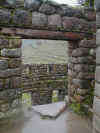 On Wednesday morning we got up early
and went back up to Machu Picchu, this time by bus. It was very overcast
and the low-hanging clouds gave the place a completely different feel from the
sunshine of the day before. After about an hour a light rain
started. We sat at the highest point in the ruins on a rock overlooking
the valley below, watching the clouds swirl around. It looked amazing, and
we were glad we were able to come back for a second day.
On Wednesday morning we got up early
and went back up to Machu Picchu, this time by bus. It was very overcast
and the low-hanging clouds gave the place a completely different feel from the
sunshine of the day before. After about an hour a light rain
started. We sat at the highest point in the ruins on a rock overlooking
the valley below, watching the clouds swirl around. It looked amazing, and
we were glad we were able to come back for a second day. 
After spending another three hours or
so exploring, we hiked back down the mountain into town. During our hike
down we were past repeatedly by several of the local "chaski" boys,
who run down the trail, leaving Machu Picchu at the same time as the tourists
buses. At each point where the trail crosses the road, they run into the
road ahead of the bus, waving and shouting at the tourists. At the bottom
of the mountain they get on the bus and collect tips. We figured these
kids grow up to be porters.
We decided to check out the local hot
springs after talking to a couple from Amsterdam who were going that way.
He knew Iris, a girl from Amsterdam whom we had met at the Palenque
conference. Small world...
Aguas Calientes gets its name from
these natural hot springs and the walk up to them was certainly beautiful.
But once we got there we weren't compelled to stay long. The water was
murky and lukewarm at best. and filled with people whose idea of bathing attire
ranged from pantyhose to t-shirts. The air smelled decidedly
UN-chlorinated. We questioned why we had paid 5 soles each to get in this
yucky water when we had the nicest hotel room in town with a great shower and a
fireplace.
That night we had a fire in our
fireplace and ordered room service. We had to call the front desk to get
someone to come start the fire and bring wood. He showed up with a little
plastic margarine pail of gasoline, splashed some on the wood, and threw in a
match. It reminded me of some episodes in my childhood when my father
became frustrated while trying to start a fire, and those in my immediate family
know what I'm talking about.
Room service and a fireplace are
nice, but the biggest luxury in our room was a space heater. Since our
arrival in Peru, we had only seen one other one, and that was in our classroom
at ACUPARI. Despite temperatures consistently in the 50's, no buildings in
Peru, including hotels and government buildings, like airports, have
heating. Most of the time it's pretty cold inside the buildings, and we
usually end up wearing most of our warm clothes all of the time. Having
the heater in our hotel room allowed us to dry our boots and some other
clothes. It was nice!
Thursday was our last day in
town before going back to Cusco on the 5:45 train, and we spent the day working
on the web site. We chose to take the local train back instead of the more
luxurious and faster tourist trains. The local train cost only 15 soles
and we figured we'd better start living like poor people again. The ride
back was crowded and chaotic. People who had bought their tickets late in
the day didn't have a seat, so the aisles were jammed with people. We
started talking with two girls who had hiked the Inca Trail with another group
from SAS, and they were getting off the train in Ollantaytambo to take a local
bus to Cusco. We found out that this is gets you to Cusco about 1 1/2
hours earlier than the train! So we tagged along with them and made it
into Cusco around 9:45.
We checked into a really interesting
hotel that was recommended by the South American Explorer's Club called The
Ninos Hotel. A woman from The Netherlands opened this hotel in 1996 in
hopes of helping the many street children of Cusco. This is one of the few
downsides to Cusco. There are hundreds of children under the age of 10
living in the streets. Commonly, their parents move to Lima to look for
work and abandon them, and they have no where to go. Some of them sell
candy and cigarettes, others shine shoes or sell postcards. It is
extremely sad, and determining the right way to help them isn't easy. The
Ninos Hotel was founded to improve the plight of these children. All
proceeds go to the street children, and soon they will open a restaurant which
will feed more than 100 children per day.
Right after we got checked into our
room, Wiley got sick. Smugly, I thought, "Ah, that grilled meat on a
stick he ate from a street vendor in Aguas Calientes got him.". Then,
a couple of hours later, I got it too. Must have been the sandwiches we
bought for the train from what we thought was a clean, touristy
restaurant. You just never know...
The next day was Friday, and we had
to move to a hotel down the street because the Ninos Hotel was full that
night. We ran some errands but were both feeling pretty poorly from the
night before. Another adventure loomed large before us, as we were to
leave for Iquitos and the jungle on Saturday, so we packed our bags and went to
bed early.
Click
here to continue in Peru/Bolivia with "At Home in the Amazon"
|





